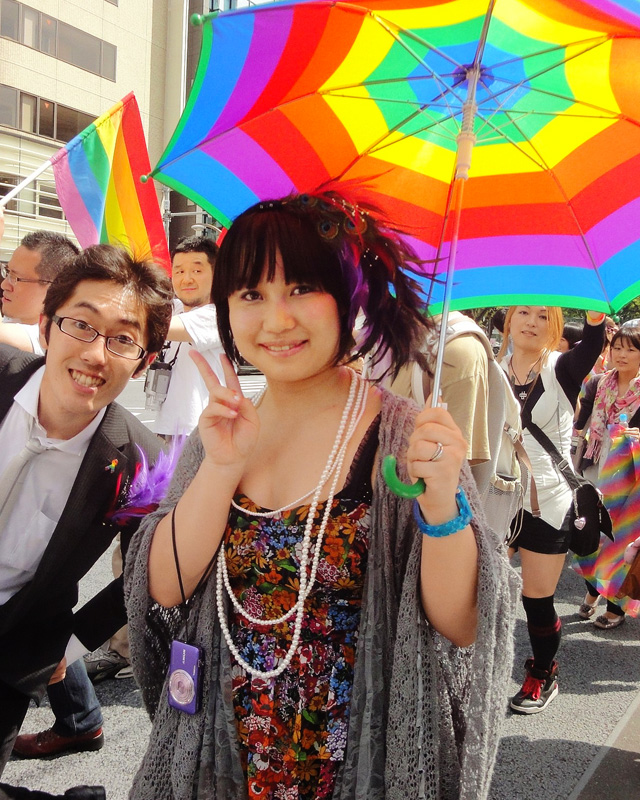
Rainbow flags and umbrellas at the Tokyo Pride Parade. Photo © Lauren Anderson, licensed Creative Commons Attribution & ShareAlike.
Sexual orientation in Japan is not such an either/or dichotomy as in the United States, so there’s less emphasis on public “outing”.Kabuki theater has had an all-male cast for 400 years, and male actors who play female roles (onna-gata) attract a huge fan base and are often described as being more alluring than women. Similarly, the Takarazuka musical theater in Hyogo prefecture is known for its all-female troupe and attracts a mostly female audience. Many adolescent girls express an adoration for Takarazuka actresses who play male roles.Compared to the United States, Japanese society seems rather nonchalant toward gender, as far as dress and mannerisms go. Cross-dressing is a common feature of comedy shows and even company parties, after the men are sufficiently inebriated. There are popular male TV personalities and singers who dress as women and act “feminine.” Many of these came out of the “gay boom” in the 1990s, a period of increased media exposure for gays and lesbians that paralleled somewhat GLBT attention in the West.
Sexual orientation and expression seems to be on a continuum, without strict boundaries, at least during youth. Young Japanese guys are often rather soft-spoken and gentle in dress, speech, and manner, and might be thought of as “feminine” by macho U.S. standards. But not so in Japan—girls consider them masculine. Novels and manga taking up the theme of love between the same sex are very popular, especially among teenage girls and young women. Girls having crushes on older female students in junior and senior high school is very common, and seems to be a part of adolescence. At an all-girls junior high school in Tokyo I attended, younger girls would often write “love notes” to older girls, expressing their admiration and feelings—then they’d ask another girl to deliver them, as they were too shy.
It’s common to see teenagers of the same gender holding hands (girls and young women) or walking arm in arm (both genders) in public. Japan has no legal prohibitions against same-sex attraction or homosexuality. Perhaps because of this, there doesn’t appear to be any movement for legalizing same-sex marriage, as there is in the United States. On the other hand, there is a lot of social pressure to marry, and being single too long is considered a handicap for men in the business world. But more and more young women are now choosing to be single and choose their own path.
Sexual orientation in Japan is not such an either/or dichotomy as in the United States, so there’s less emphasis on public “outing.” What you do in your private life and with your in-group is your own business. You won’t see large gay pride parades, as in the United States, although they pop up occasionally on a smaller scale.
Excerpted from the Third Edition of Moon Living Abroad in Japan.